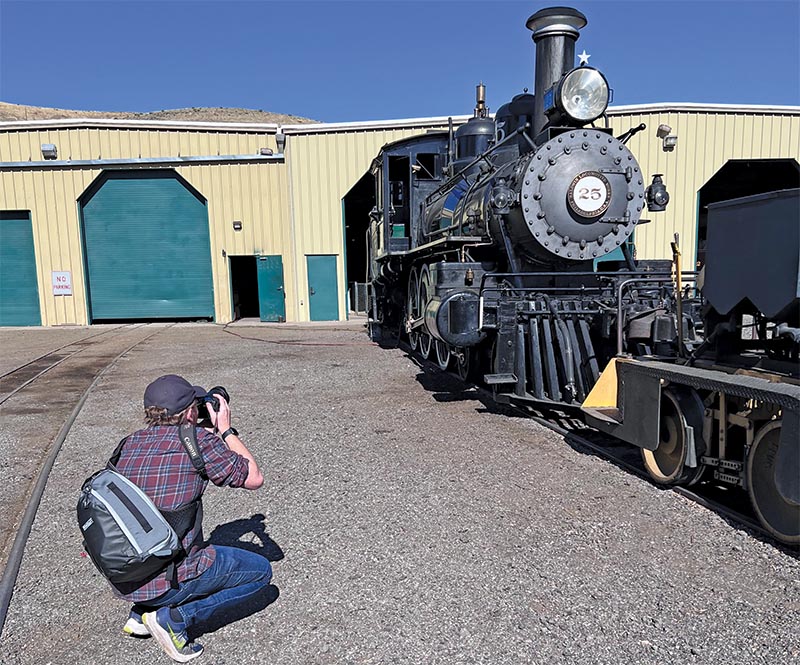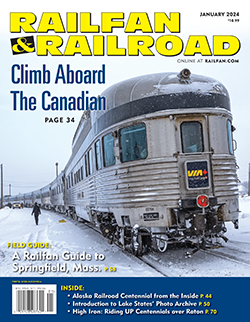 by Justin Franz/photos as noted
by Justin Franz/photos as noted
Since this column was first published 50 years ago, the topic of gear has come up countless times. The first Camera Bag that Founding Editor Jim Boyd wrote back in the Winter 1974 edition of Railfan exclusively covered what type of gear the magazine staff was using at that time (mostly the Nikon F-series of cameras, which was popular with photojournalists and professional photographers of the day, usually loaded with Kodachrome for color slides or Plus X and Tri-X for black & white prints).
A half-century later, digital cameras have replaced film cameras. Editor Steve Barry shoots Nikon and Managing Editor Otto Vondrak is a Canon guy (finally trading his film body for digital at my recommendation, a clear win for those of us on Team Canon). Presently, I’m shooting with two Canon EOS R bodies. The R was the first in Canon’s full-frame mirrorless lineup released in 2018, and while the series has made huge advancements in the last five years, I still like the original offering — mostly because in the last four years of shooting with it, I’ve gotten to know it pretty well and don’t have to think much when using it; I can just focus on the photography.
For all the talk about equipment in this column, however, the topic of camera bags themselves has only come up a few times. In the November 1988 edition, not long after Bruce Kelly joined the staff as associate editor, Boyd emptied out the new arrival’s bag (a Tamrac Super Pro that weighed 30 pounds) to compare a “Western” railfan’s setup to his own. The column went on to state that Boyd’s car often served as an extension of his camera bag, but Bruce packed everything he needed in one well-organized spot.
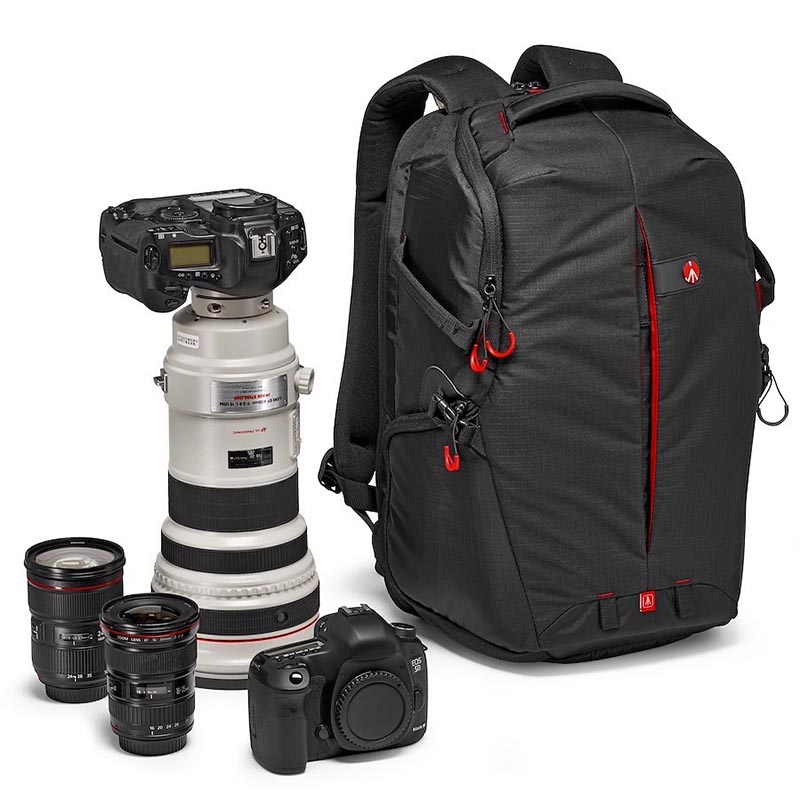
ABOVE: The Manfrotto RedBee-210 with comparitive gear.
After years of trial and error, I finally found the bag — or should I say bags — that work well for me and my workflow. My primary bag is a Manfrotto RedBee-210 that, when fully loaded, weighs just over 20 pounds (manfrotto.com, although it appears this bag might not be available any longer; there are, however, other versions in the RedBee lineup). The bag is rugged, well-designed, and somewhat weather-resistant; it also comes with a protective rain cover. In that, I can hold two Canon EOS Rs (with battery grips attached) and all my lenses (a handful of zooms, a fixed 50mm, and a 70–200mm). In the main compartment, where the cameras and lenses go, you’ll also usually find a scanner, a small bag of batteries (the standard Canon ones, plus AA for the scanner and, in a pinch, to load into the battery grip), and a RODE microphone for taking video on occasion. Also tucked into that main compartment, you’ll usually find a high-visibility vest and some safety glasses. I know there are some railfans out there who advocate for wearing a high-visibility vest while trackside while others think it’s unnecessary at best and absurd at worst. I generally think it’s unnecessary. However, I have been in situations where I was invited “onto the property” by a railroader and already having the vest saved valuable time. Because of that, I always keep it in the bag just in case.
The back of the pack unzips so you can access all your gear, and there are a number of pockets. In the primary pocket, I keep a cable release, a Pelican memory card case (Pelican is known for making strong cases so I assume I could run it over with a car and be fine, but I’m not going to try that), a flashlight, the battery grip insert to load the camera with AA batteries should I need to, a small notebook, a few pens, an off-brand Swiss Army knife, ear plugs, lens cloths, a rubber dust blower, my passport, my Part 107 drone pilot’s license, and, on occasion, a granola bar if I know I’m going to be off in the sticks for awhile.
Finally, there’s another pocket in the back that is perfect for paperwork, timetables, and other flat(ish) items. In there, I keep a sectional aeronautical chart for my region (I have used it once to figure out if I could safely and legally fly the drone) and various timetables. The timetable you’ll always find in there is a well-worn copy of Altamont Press’ Northwest Region 8 (Alaska, Idaho, Montana, Oregon, and Washington), a must for railfanning in my corner of the country. Another timetable that is also often with me when traveling north of the border, although it never fits in the bag, is the invaluable Bytown Railway Society Canadian Trackside Guide. Other things that often get carted around outside the bag like the trackside guide are maps (including various DeLorme atlases for the U.S.), the Backroad Mapbooks for Canada, and a few U.S. Forest Service maps for various spots in the Northwest where those DeLorme atlases just aren’t detailed enough.
Looking back at that previous column again, I thought it particularly interesting that, 35 years later, there really isn’t much difference between what Bruce was carting around in 1988 and what I’m carting around in 2024. The only real difference is a lack of film in my bag (although that’s not the case when the Minolta X-370 gets slipped into one of those empty pockets). By the way, I checked with Bruce and he still has that massive 30-pound Tamrac Super Pro camera bag, although he uses a much more compact shoulder bag for most of his railfanning these days.
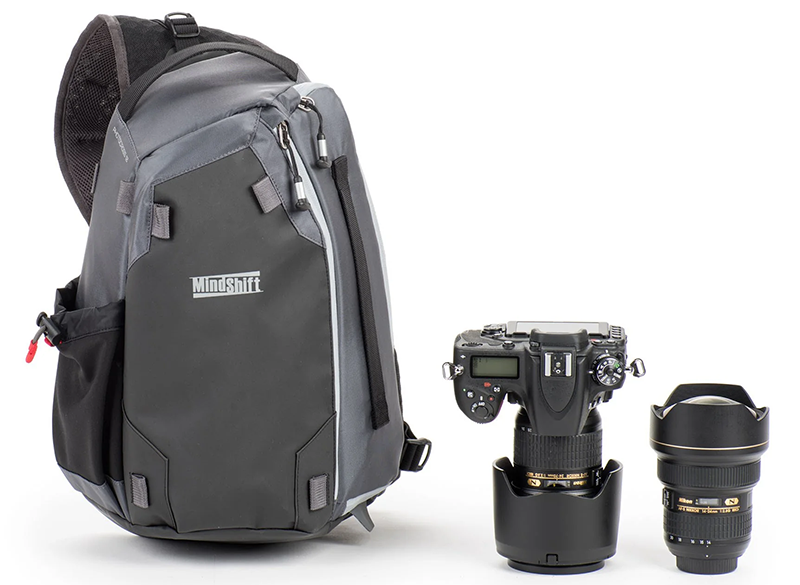
ABOVE: MindShift PhotoCross 10 with comparitive gear.
And speaking of shoulder bags… In recent years, I’ve acquired two other bags that I often employ while trackside, depending on my needs. The first is the MindShift PhotoCross 10 ($124.75 at thinktankphoto.com or other retailers), a shoulder bag that can fit a DSLR body (minus the battery grip) and a few lenses. I’ve also been able to slip in a smaller mirrorless body (specifically the Canon M6) as a backup camera along with the abovementioned. I’ve found this bag to be especially useful for traveling when you’re going to be riding public transit or walking a lot. Just last spring, I found it particularly useful while railfanning Metra’s “Racetrack” on a bicycle (see Markers in the June 2023 issue for more on that adventure). Not only does it have a nice compartment for a camera and some lenses, but it also has a front pocket that’s perfect for a notebook, some pens, tickets, extra memory cards, and more. The bag is not particularly big, so it isn’t cumbersome to lug around, and fully loaded it weighs less than 10 pounds. It’s also easy to swing the bag from your back to your front to change lenses while standing or walking.
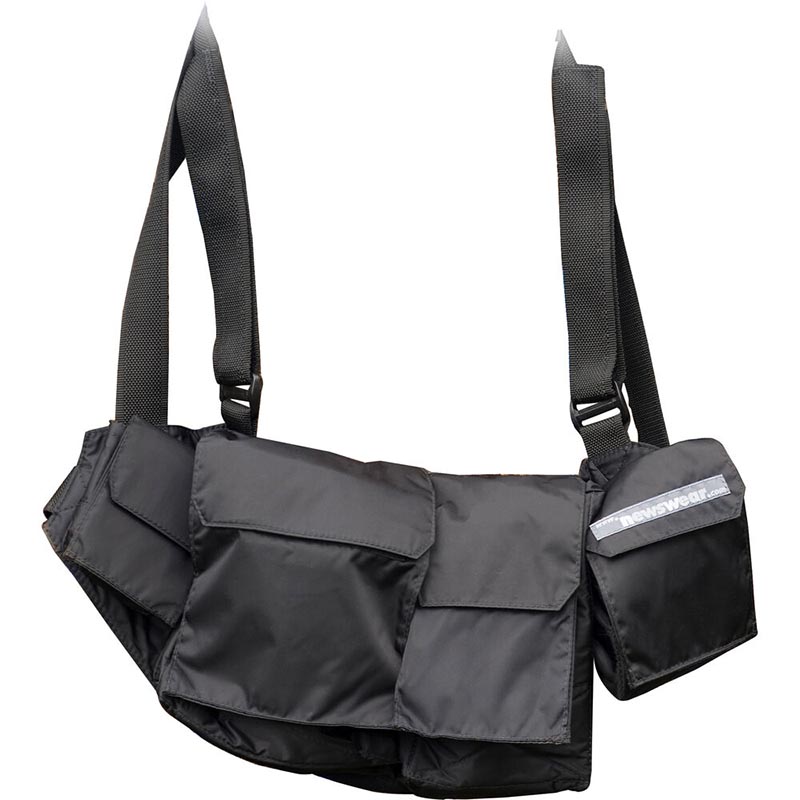
ABOVE: Newswear Chestvest
The last bag in my arsenal isn’t really a bag at all, but rather a belt. The “Chestvest” from Newswear ($192 at newswear.com) is popular with photojournalists and sports photographers and it’s what I use whenever I’m going to be doing “serious” shooting — when I know I’ll be changing lenses a lot or won’t have time (or often the space) to take off the backpack, kneel down, and dig through it for the right lens. The first time I encountered this bag was when I was working at a newspaper, and I finally got my own a few years ago when Railfan & Railroad contributor David Busse was cleaning out an old closet and found an extra. Of all the products mentioned here, this is the one I can’t say enough good things about. Made of nylon, the belt is waterproof and has four main compartments that can hold a full DSLR body with the battery grip attached and multiple lenses, including long telephotos. There are also pockets for a notebook, extra batteries, and more. It is mind-boggling just how much this thing can carry. While as purchased the belt hangs off your chest, I modified mine by cutting one of the straps so that it hung toward my side, and I could have my primary camera on my other side where I normally wear it. In the field, this is also the easiest of the previously mentioned bags to use; I can flip open the Velcro flap, reach in to grab a lens, and put it on a camera in a matter of seconds. It also keeps all the gear close to your body and doesn’t get in the way when climbing on and off pieces of equipment. If you participate in a lot of photo charters or other events where you’re going to be away from your car or don’t want to lug around a big camera bag, I highly recommend the Newswear belt.
Railroad photographers often put a lot of thought into the cameras and lenses they use, but sometimes what we put them in is an afterthought. That doesn’t make a lot of sense to me, especially when some of these modern digital cameras can cost a pretty penny. I should note that what I’ve written above is what works for me, and everyone is different. Some people prefer a more traditional bag over the shoulder, while others like a hard case for the protection it provides. Some don’t have a camera bag at all. In the end, what matters is that you get out and use that camera.


